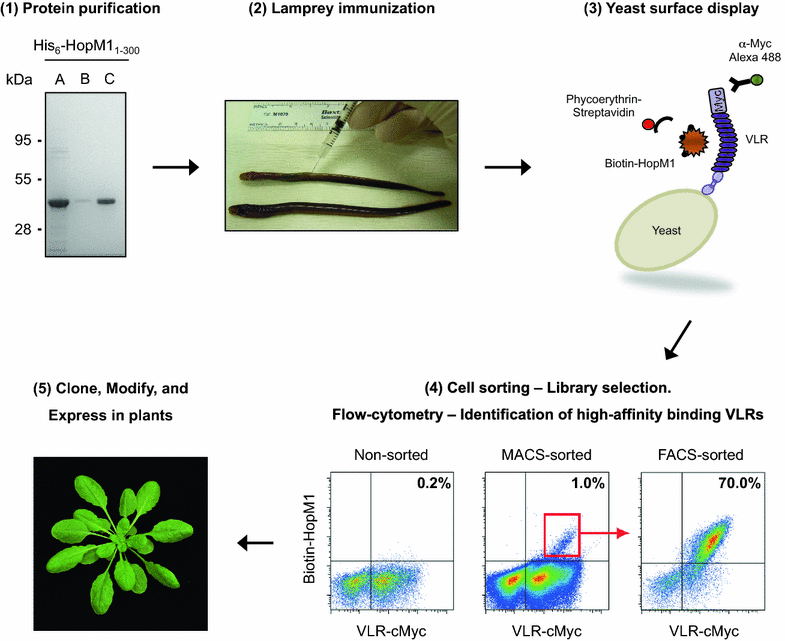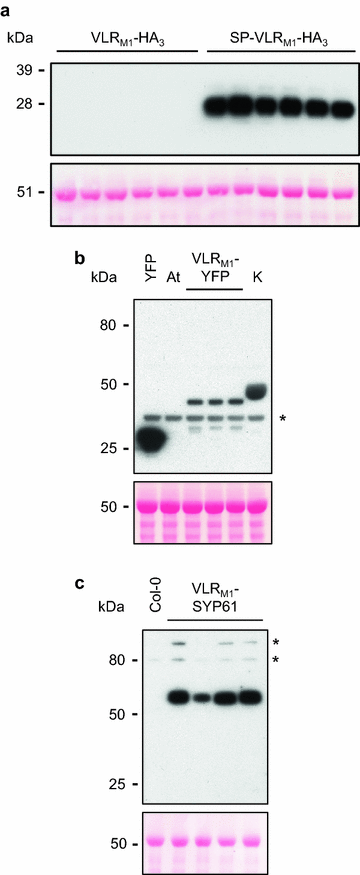Leucine-rich-repeat-containing variable lymphocyte receptors as modules to target plant-expressed proteins
- PMID: 28428809
- PMCID: PMC5395774
- DOI: 10.1186/s13007-017-0180-8
Leucine-rich-repeat-containing variable lymphocyte receptors as modules to target plant-expressed proteins
Abstract
Background: The ability to target and manipulate protein-based cellular processes would accelerate plant research; yet, the technology to specifically and selectively target plant-expressed proteins is still in its infancy. Leucine-rich repeats (LRRs) are ubiquitously present protein domains involved in mediating protein-protein interactions. LRRs confer the binding specificity to the highly diverse variable lymphocyte receptor (VLR) antibodies (including VLRA, VLRB and VLRC types) that jawless vertebrates make as the functional equivalents of jawed vertebrate immunoglobulin-based antibodies.
Results: In this study, VLRBs targeting an effector protein from a plant pathogen, HopM1, were developed by immunizing lampreys and using yeast surface display to select for high-affinity VLRBs. HopM1-specific VLRBs (VLRM1) were expressed in planta in the cytosol, the trans-Golgi network, and the apoplast. Expression of VLRM1 was higher when the protein localized to an oxidizing environment that would favor disulfide bridge formation (when VLRM1 was not localized to the cytoplasm), as disulfide bonds are necessary for proper VLR folding. VLRM1 specifically interacted in planta with HopM1 but not with an unrelated bacterial effector protein while HopM1 failed to interact with a non-specific VLRB.
Conclusions: In the future, VLRs may be used as flexible modules to bind proteins or carbohydrates of interest in planta, with broad possibilities for their use by binding directly to their targets and inhibiting their action, or by creating chimeric proteins with new specificities in which endogenous LRR domains are replaced by those present in VLRs.
Keywords: HopM1; Leucine-rich repeat; Modules; Protein targeting; Variable lymphocyte receptor.
Figures





Similar articles
-
Identification of Glycan-Specific Variable Lymphocyte Receptors Using Yeast Surface Display and Glycan Microarrays.Methods Mol Biol. 2022;2421:73-89. doi: 10.1007/978-1-0716-1944-5_5. Methods Mol Biol. 2022. PMID: 34870812 Free PMC article.
-
Copy number and sequence variation of leucine-rich repeat modules suggests distinct functional constraints operating on variable lymphocyte receptors expressed by agnathan T cell-like and B cell-like lymphocytes.Immunogenetics. 2014 Jun;66(6):403-9. doi: 10.1007/s00251-014-0773-6. Epub 2014 Apr 24. Immunogenetics. 2014. PMID: 24760209
-
High-affinity lamprey VLRA and VLRB monoclonal antibodies.Proc Natl Acad Sci U S A. 2009 Aug 4;106(31):12891-6. doi: 10.1073/pnas.0904443106. Epub 2009 Jul 22. Proc Natl Acad Sci U S A. 2009. PMID: 19625627 Free PMC article.
-
Leveraging the biotechnological promise of the hagfish variable lymphocyte receptors: tools for aquatic microbial diseases.Fish Shellfish Immunol. 2024 Jul;150:109565. doi: 10.1016/j.fsi.2024.109565. Epub 2024 Apr 17. Fish Shellfish Immunol. 2024. PMID: 38636740 Review.
-
Evolution of adaptive immunity: implications of a third lymphocyte lineage in lampreys.Bioessays. 2014 Mar;36(3):244-50. doi: 10.1002/bies.201300145. Epub 2013 Dec 19. Bioessays. 2014. PMID: 24853392 Review.
Cited by
-
Generation of Lamprey Monoclonal Antibodies (Lampribodies) Using the Phage Display System.Biomolecules. 2019 Dec 12;9(12):868. doi: 10.3390/biom9120868. Biomolecules. 2019. PMID: 31842457 Free PMC article.
-
Development of smart anti-glycan reagents using immunized lampreys.Commun Biol. 2020 Feb 28;3(1):91. doi: 10.1038/s42003-020-0819-2. Commun Biol. 2020. PMID: 32111965 Free PMC article.
-
The variable lymphocyte receptor as an antibody alternative.Curr Opin Biotechnol. 2018 Aug;52:74-79. doi: 10.1016/j.copbio.2018.02.016. Epub 2018 Mar 26. Curr Opin Biotechnol. 2018. PMID: 29597074 Free PMC article. Review.
-
Novel lamprey antibody recognizes terminal sulfated galactose epitopes on mammalian glycoproteins.Commun Biol. 2021 Jun 3;4(1):674. doi: 10.1038/s42003-021-02199-7. Commun Biol. 2021. PMID: 34083726 Free PMC article.
-
DNA Methylation Level Changes in Transgenic Chinese Cabbage (Brassica rapa ssp. pekinensis) Plants and Their Effects on Corresponding Gene Expression Patterns.Genes (Basel). 2021 Sep 30;12(10):1563. doi: 10.3390/genes12101563. Genes (Basel). 2021. PMID: 34680957 Free PMC article.
References
-
- Stergiopoulos I, van den Burg HA, Okmen B, Beenen HG, van Liere S, Kema GH, et al. Tomato Cf resistance proteins mediate recognition of cognate homologous effectors from fungi pathogenic on dicots and monocots. Proc Natl Acad Sci USA. 2010;107:7610–7615. doi: 10.1073/pnas.1002910107. - DOI - PMC - PubMed
Grants and funding
LinkOut - more resources
Full Text Sources
Other Literature Sources

